
-
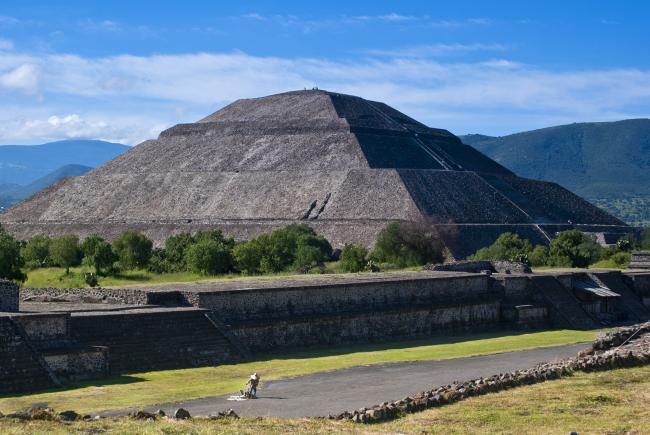
Pirámide del Sol
-

Pirámide del Sol
-

Serpiente en espiral enmarcada por diseño de greca escalonada
-
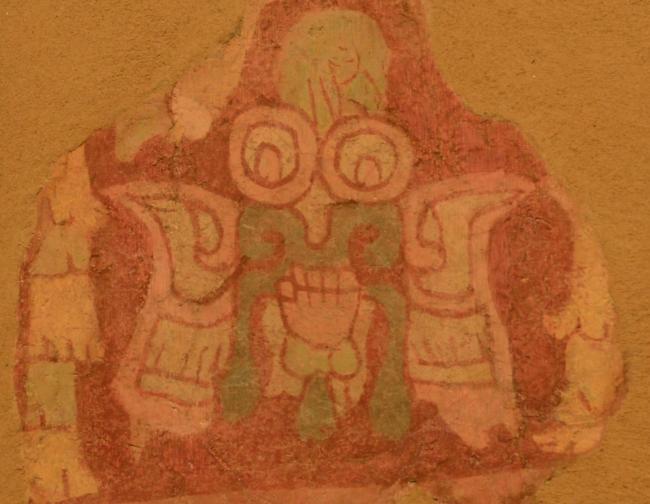
Mariposa con grandes ojos de círculos concéntricos y mano humana en su cuerpo
-
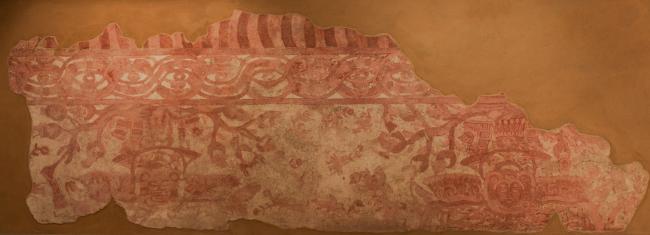
Grandes murales de figuras aladas descendentes
-
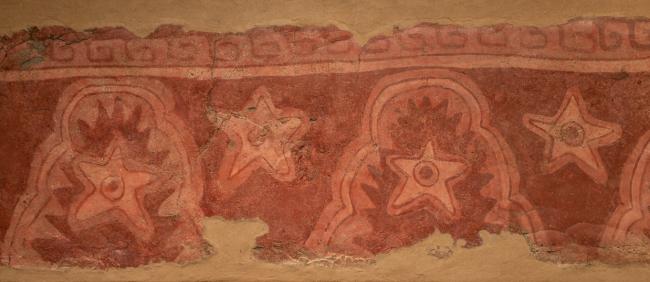
Diseño con formas polilobuladas que alternan con estrellas de cinco puntas
-

Jaguar delineado en azul con el rostro de frente, planta de maguey, mariposas, aves y flores
-
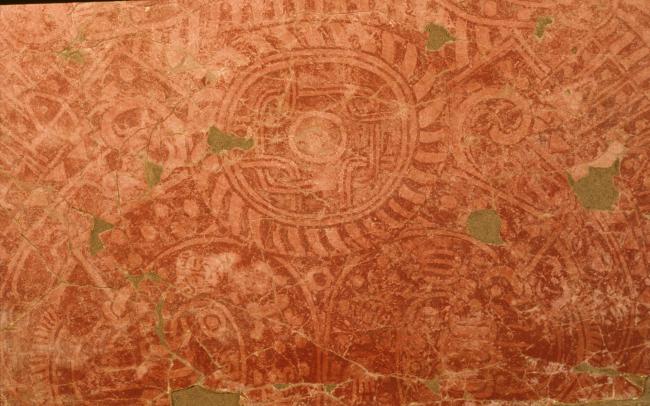
Figura frontal con entrelaces garras y corriente
-
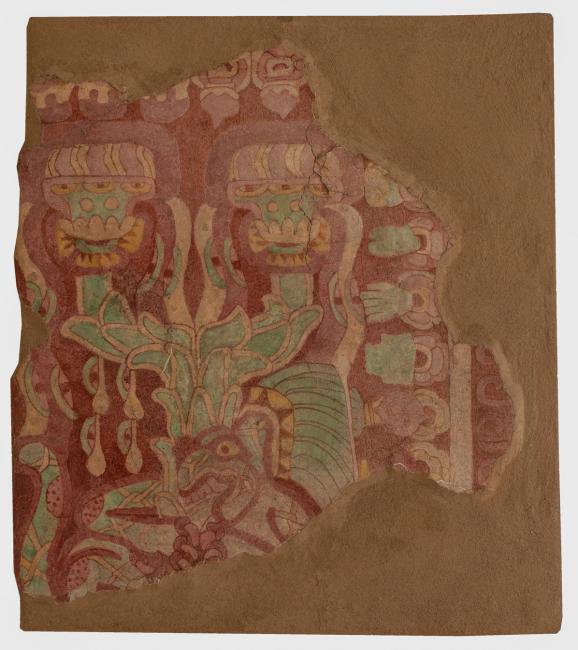
Jaguar abrazando ramas estilizadas de maguey
-
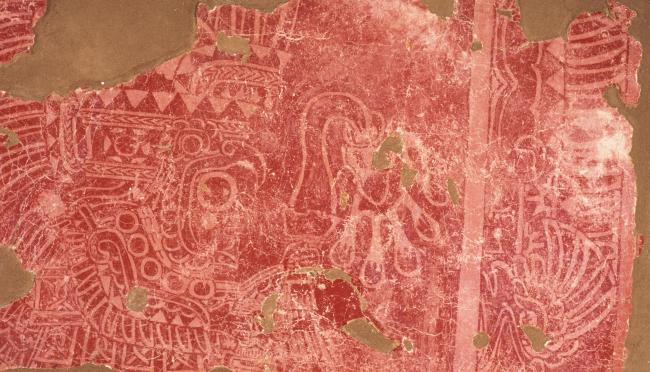
Figuras humanas de perfil con disfraz de ave y sosteniendo un cuchillo curvo
-

Figura de ave vista de frente sobre escudo con estrella de cinco puntas
Conjunto del Sol
It consists of the Great Pyramid of the Sun, an outstanding platform, a rectangular plaza, which also concentrates three small temples and a shrine, an administrative unit and a residential area, All these elements create one of the most complex and monumental urban spaces of pre-Hispanic America.
Pyramid of the Sun: It is one of the oldest buildings in the city, 65 m high and 224 m per side at its base, it is the largest in the city; in one of the surrounding residential complexes about 30 murals with diverse representations, mostly polychrome, were detected.
Spiral snake framed by a stepped fretwork design: It is a spiral snake; in its center the stylized head is seen in profile; above and to the left is the tail exhibiting three geometrized petals, its features include the eye composed of three concentric circles, from this descends an inclined appendage, the mouth is open and inside are recognized pointed teeth, the ear is, like the mouth, a kind of trunk, a wide scroll.
The head, in fact, does not look like that of a snake, it is a fantastic animal; the body is a wide strip sectioned by staggered lines, in red and yellow sections, a dark blue band outlines it. On the outside, following the outline of the serpentine body, it is framed by a design of staggered fretwork -alternating a red and a yellow one- which ends leaving space for the representation of the petals. It had a border of stepped fretwork design limited by bands with red and yellow triangles, the schematic and geometric style differs notably from the "classic" Teotihuacan times.
Fuente, Beatriz de la (coord.), 1995, La pintura mural prehispánica en México Teotihuacán, volume I, Mexico, UNAM/IIE.
Butterfly with large eyes with concentric circles and human hand on its body: Large eyes composed of concentric rings and eccentric pupils are visible in the central middle part of the inner ring; in the center, where the two rings meet, the antenna of the spiral-shaped butterfly rises, it has a red perimeter and a pink background, a semi-oval shape in light green stands out.
The body is composed of a right human hand that seems to hold up two meanders and, on each side, a narrow band that curves downward and ends in a pointed appendage; the fist of the hand is covered by a knot band in green and a blue pendant, all on a rectangular surface in pink tone; the schematic wings show green designs on the inside, have tucks towards the inner side and in the design of the lower part they carry parallel vertical lines; on both sides of the butterfly's body there are polychrome designs whose shape is unrecognizable.
Fuente, Beatriz de la (coord.), 1995, La pintura mural prehispánica en México Teotihuacán, volume I, Mexico, UNAM/IIE.
Large murals of descending winged figures: It is a descending character with extended wings that end with small bird heads that have a strong and hooked beak and a crest of small feathers; below his face there is a kind of garland -formed by what seems to be maguey leaves- that extends below the wings.
This personage carries a skirt or feathered cape on whose sides appear again the heads of birds, his left foot can also be seen wearing a sandal; his face is framed by a helmet in the shape of a frontal zoomorphic figure, the beak is directed to the center, both in the upper and lower part, his nostrils look more like a feline than a bird, the eyes of the helmet are crowned by feathers. The character's mouth is trapezoidal in shape and shows its teeth; it wears rectangular blinkers and a stepped mouth mask.
Above the helmet and the ends of the eyes there is a half circle that shows in its interior five-pointed stars; downwards is his right hand, from which a stream flows; above his body sprouts a plant that extends towards the ends, the leaves are pointed and are the same in each stem except for those that have flowers, in them appear different elements of auction: a rectangular figure from which fall three drops, two parallel bars separated by an interlace and other elements that cannot be clearly appreciated.
In the space between the border, the figure and near the plant, butterflies and a bird with a long, twisted neck can be seen; the border is formed by bands of interlaces: one of them is composed of a sequence of what looks like floral elements and the other by alternating eyes and jagged rays.
Fuente, Beatriz de la (coord.), 1995, La pintura mural prehispánica en México Teotihuacán, volume I, Mexico, UNAM/IIE.
Design with poly-lobed forms alternating with five-pointed stars: It is a border limited in its external perimeter by a band of scrolls whose inward curves are found in the center. On the inner surface, on a dark red background, there are alternating poly-lobed designs with five-pointed stars; in the inner space of these designs, the five-pointed stars are repeated, some of which have pointed and radial shapes in dark red.
Fuente, Beatriz de la (coord.), 1995, La pintura mural prehispánica en México Teotihuacán, volume I, Mexico, UNAM/IIE.
Jaguar outlined in blue with a frontal face, maguey plant, butterflies, birds and flowers: The center of the mural and of the composition is marked by the stem of a maguey that overlaps the body of the jaguar, whose head is composed of two profiles, has round eyes, open jaws showing fangs on the upper gum and a forked tongue with inward curved ends; two sections compose its headdress -each one corresponds to a profile of the large head- and a half fan composed of long feathers that stands from a headdress holder of found triangles.
The surface of the feline's body is decorated with interlaces, the front left paw is positioned in front and the right one is embraced to the stem of the maguey, only the back right paw is observed in profile, the tail is curved and descends on what remains of a band with stars in the interior that simulates water, where a feline poses.
The stem of the plant rises and divides in three branches: two towards the sides and one in the center, from the three ascend flowers of four petals to which are superimposed other flowers of profile that show the corolla and the petal, in their interior they take three disks and three eyes, in the high parallel wavy lines are appreciated. On the sides of these composite flowers are placed, on each side, three bands with eyes inside that snake down; in the spaces between the bands and the feline are butterflies with their wings extended and a bird in profile with a large virgula coming out of its beak.
The scene is framed by a border, formed by symbols composed of flowers with four petals in whose inner part are attached and alternate shells of different types, sectioned and complete snails.
Fuente, Beatriz de la (coord.), 1995, La pintura mural prehispánica en México Teotihuacán, volume I, Mexico, UNAM/IIE.
Frontal figure with interlaced claws and current: It is a large symbolic figure represented from the front, instead of a face it has a kind of shield that inside it carries concentric circles and a disk at the center framed by double and interlaced lines, surrounded by another outer ring composed of a design of feathers curved in the same direction; above the shield extends as a large fan a huge headdress that is made up of the following parts: the lowest, above the shield, is formed of a row of tabs pointing downward; above it extends a band that curves at the ends and inside of which is noted, horizontally, a row of discs; at a higher level a wider band than the lower one is observed, follows the same curvature and is decorated inside with a row of drops; another narrow band repeats the shape and design, with a series of discs in a horizontal direction.
In the center and at the top of the aforementioned bands, there is a kind of square in whose interior there are discs, a silhouette in the form of a stool from which four appendages that simulate fangs are raised and curved outward. The square is limited at the top by two curved bands: the inner one has discs and the outer one has triangles in two shades of red. On the sides of the lower part, which resemble the open jaws of an animal, extends on each side and horizontally, a plate with pointed appendages.
Framing the sections of the headdress mentioned above, there are diagonal bands with discs and triangles inside them, from which three drops fall on each side; two plumes of feathers, one on the sides of the lower sections and the other at the top, enhance a magnificent headdress.
Fuente, Beatriz de la (coord.), 1995, La pintura mural prehispánica en México Teotihuacán, volume I, Mexico, UNAM/IIE.
Jaguar embracing stylized maguey branches: In the fragment a feline image is appreciated whose head is in profile and looking to the right side; the arms and legs with their respective claws, seem to be in front embracing the plant stem that has been identified as maguey, while its erect tail curves to the right in a convex way.
The face of the feline has an elliptical eye, the erect ear, the flat nose showing the nostril and the half-open jaws with teeth and fangs in the upper gum; the head, extremities, body and tail of the jaguar have intertwined bands or nets; in the extremities and tail there are semioval forms with dots in its interior.
It wears a fan-shaped headdress, its base or “portatocado” is a band of triangles that holds long green feathers; above the feline's head rises the stem with maguey leaves, at the top it bifurcates with two branches, one on each side of its center, and from each of these, a stem rises that holds a flower of four petals -the upper one is hidden- with triangles inside, and another flower seen in profile, with corolla and petals inside which are two discs and three eyes directed upwards, above the petals are parallel wavy lines and a wide red band in the form of a fan; as if forming part of this section of the maguey plant, on both sides, wavy bands with eyes descend inside, from the right branch four drops with their respective eyes descend.
The fragment is framed by a border composed of bivalve shells and snails, which hide the lower petal of the four-petal flower in its upper part; on the left side of the border there are remains of shells, snails and a hand that comes out of the flowers of four petals, in the external part there are remains of a fringe with volutes.
Fuente, Beatriz de la (coord.), 1995, La pintura mural prehispánica en México Teotihuacán, volume I, Mexico, UNAM/IIE.
Human figures in profile with bird costume and holding a curved knife: Two human figures seen in profile, both with one foot behind the other and holding in their hand a curved knife that slits through the center of an image resembling a sectioned heart, from which hang five drops.
Few elements of the human figure are visible: a necklace of circular beads, feet that go one behind the other, and shod with sandals, of the face large rings are appreciated around the eyes and the left hand rises to take a curved knife; the headdress or helmet, that frames the face in profile, is the beak of a bird with eye and feathers, has a horizontal section with stars in its interior, limited by a band of petalillo and straight triangles in two tones of red.
Above it rises a plume of long feathers that form the silhouette of a half fan; below and to the back of the head of the human figure, another bundle of four feathers extends from which descends a kind of band or stream with symbolic designs in its interior.
From the costume of the character we can appreciate a kind of cloak composed of different sections: an extended scroll that looks like the articulation of the wing of a bird; below this last one a band with circular designs; then another band of triangles found in two tones of red; of greater amplitude than the previous ones a band formed by feathers; and finally in the bottom, another band of bangs in the form of X.
The border that limits the design is different on the two vertical sides, on the extreme right it is made up of five straight bands that move vertically and at the top they bend in a horizontal direction: one of these bands, on the inside, is a plain band of light red color, the following one, towards the outside, is a band with a row of footprints that follow the same direction; another on the outside is similar to a band of five-pointed stars and a central disk; another band is made up of pointed triangles in two shades of red.
Finally a band formed by a row of feathers; a rectangular form -in the lowest part- from which four curved and long feathers descend, gathers the bands described above. At the other end of the border the bands vary in their interior design: vertical water waves, footprints and feathers ending in a zoomorphic head looking down.
Fuente, Beatriz de la (coord.), 1995, La pintura mural prehispánica en México Teotihuacán, volume I, Mexico, UNAM/IIE.
Figure of a bird seen from the front on a shield with a five-pointed star: In the fragment of this mural, in addition to the straight bands folded in a spiral with the rows of disks inside, the figure of a bird seen from the front can be recognized; its eyes are concentric circles, composed of bands of different colors, the bird is seen above a disk .shield or buckler?- in whose center is placed a five-pointed star, and narrow blue and yellow bands surround it, another wider band with feathers inside forms the outer band of the disk.
Fuente, Beatriz de la (coord.), 1995, La pintura mural prehispánica en México Teotihuacán, volume I, Mexico, UNAM/IIE.

